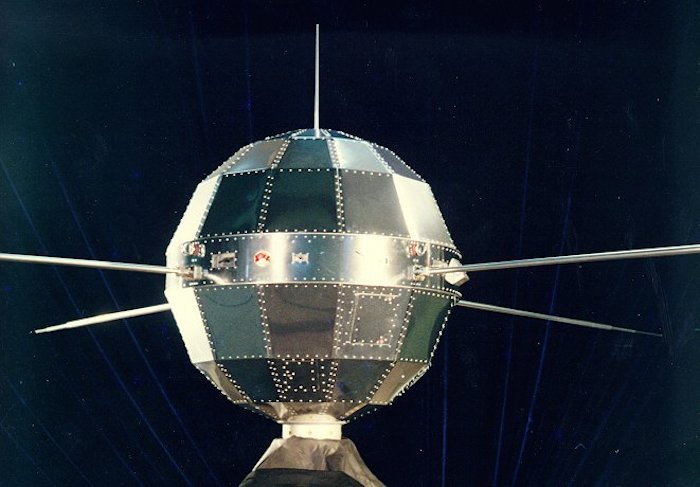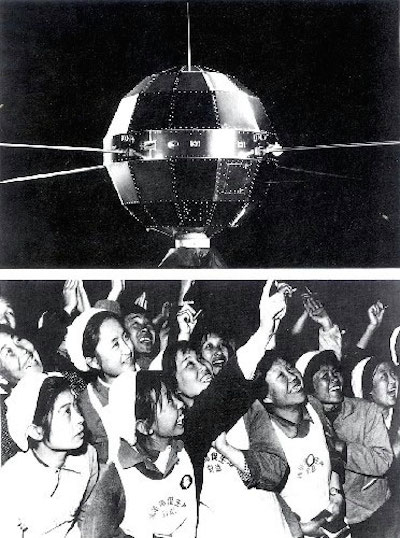.

Xinhua Insight: How China joins space club?
.
Yu Jun aimed his telescope at a bright star in the night sky. A moment later, a dim light passed across it, along the very path foreign astronomy websites had forecast.
"Dongfanghong-1," Yu Jun noted in his observer diary.
"I can hardly believe that several decades after its launch, China's first satellite can still be seen. It's amazing," he exclaims.
The launch of Dongfanghong-1 on April 24, 1970 marked China's entry into a new epoch of space exploration.
But less-well understood is how China developed high-end space technologies during impoverished and turbulent times.
GREAT LEAP FORWARD
In 1957, the Soviet Union and United States each launched their first satellites, officially starting a space race. A year later, Chinese leader Chairman Mao Zedong proposed, "We too should produce satellites."
Scientists at the Chinese Academy of Sciences began a satellite program with the aim of launching China's first satellite in 1960.
At that time - during the Great Leap Forward - ordinary Chinese talked of "launching high-yield satellites" in a reference to reporting fictitiously high crop yields or industrial output. But a satellite launch could not be fabricated.
The young scientists worked day and night for three months and produced models of the rocket and the satellite. But many questions were left unresolved, because they lacked basic theory and computing methods. Their first attempt failed.
In the autumn of 1958, Zhao Jiuzhang and other scientists were given a cold shoulder when they visited the Soviet Union to study space technology. China had to be self-reliant to develop a satellite.
China lacked the technological industry support that was necessary for the research and development of satellites. Realizing this, the scientists decided to begin with a sounding rocket.
SOUNDING ROCKET
A sounding rocket - also called a research rocket - carries instruments for space research. Scientists believed the sounding rockets could pave the way for satellite-carrying rockets.
Yang Nansheng and Wang Xiji were appointed to head the design of a sounding rocket at the Shanghai Institute of Mechanical & Electrical Engineering in late 1950s.
Wang recalls how - with no computers - researchers had to calculate their computations by hand or by abacus. They worked in three shifts, and spent almost a month calculating an orbit. The computing papers were stacked higher than their desks.
After overcoming many barriers, they produced the T-5 sounding rocket - only to find they lacked the necessary equipment for engine testing. The rocket ended up in an exhibition display case.
"To reach space in a single bound was too ambitious," says Wang. Learning from their failures, they turned to researching the smaller T-7M sounding rocket.
The lack of funds made an incredibly shabby research environment, Wang recalls. The engine test room was a refitted toilet. The timing device controlling the separation of the head and body of the rocket was modified from a table clock. Scientists made the ignition device by taking the filament from the small bulbs of an electric torch, and wrapping them with nitro-cotton. With no equipment to pressurize the fuel, they used a bicycle pump to get the propellant in the tank.
On February 19, 1960, at the launch site on a beach in suburban Shanghai, the T-7M soared into the air, reaching 8 kilometers above the ground. There were no telephones, walkie-talkies or loudspeakers - only hand gestures and shouting.
The nation that invented the primitive rocket 800 years before had successfully launched its first modern rocket.
NEW SATELLITE PLAN
Suspension of the satellite plan failed to stifle the Chinese space dream. The Chinese Academy of Sciences hosted interstellar navigation forums 12 times from 1961 to 1964. In 1964, China successfully tested its first ballistic missile and atomic bomb.P That progress prompted the reconsideration of satellite research. Scientists Qian Xuesen and Zhao Jiuzhang suggested the central government put the satellite back on the agenda. It was approved.
In the autumn of 1965, discussions on the overall satellite plan lasted 42 days. Many scientists said it was the longest meeting they had ever attended.
They decided that the task of China's first satellite was to provide experience and data for future satellites to carry out missions such as earth observation, communication, broadcasting and meteorology.
They planned the launch for 1970.
Wang Xiji presided over the appraisal and design of the carrier rocket Changzheng 1, or Long March 1. He combined the technology of the sounding rocket and missiles in a creative way.
However, the start of the Cultural Revolution threatened to disrupt the plans.
In early 1967, many scientists, including Wang, were denounced. Rocket expert Yao Tongbin was beaten to death at the door of his home. Zhao Jiuzhang, the founder of China's satellite research program, committed suicide rather than endure more suffering. Qian Ji, who drafted the launch plan, was identified as a "reactionary of academic authority." Confined to bed by illness, Qian wrote more than 50,000 documents to record the precious research.
At a critical juncture, Premier Zhou Enlai and Vice Premier Nie Rongzhen established the China Academy of Space Technology as an arm of the military under the leadership of the Communist Party. This kept the satellite launch on schedule.
BRAINSTORMS
Although a latecomer, China's satellite was to be more advanced than those of other countries, the scientists assumed.
He Zhenghua, leader of general technology team, suggested installing a music device to play the song "Dongfanghong", or "The East is Red". Adapted from a folk song, the lyrics sing the praises of Chairman Mao.
The government approved the idea. The scientists' enthusiasm was mixed with stress, as the task was as important as the satellite itself. What if the music was out of tune or failed to work in space? It could be a huge political error.
After many experiments, they came up with suitable electronic music.
Then, how to make the satellite visible from the ground?
The limited carrying capacity confined the satellite's diameter to one meter, too small to see with the naked eye from Earth.
Inspired by a folding umbrella, scientists installed a device painted with reflective materials on the final-stage rocket. When the rocket reached space, the "observation skirt" would unfold like umbrella and be seen from Earth.
However, it failed to unfold in a vacuum environment. With the launch nearing, scientists sought desperately for a solution.
Eventually, they designed a spherical air jacket. When the rocket reached space, the jacket would inflate to a balloon with a diameter of 3 meters, which could be spotted easily.
In September 1969, the Dongfanghong-1 prototype passed the laboratory tests. But one problem still nagged chief designer Sun Jiadong.
Embedded on all the equipment, Chairman Mao badges overloaded the satellite and posed a fault risk. But opposing the badges at that time could incur political risks.
Sun Jiadong reported his dilemma to Premier Zhou Enlai, who dispelled his concerns. "Scientists should keep a scientific attitude and follow objective rules," said Zhou. The badges were removed, except one that was embedded on the music device.
.

NO PROBLEM UNSOLVABLE
China joined the "space club" on April 24, 1970, when it successfully sent its first satellite, Dongfanghong-1, into orbit with its Long March rocket. It became the fifth nation after the Soviet Union, the U.S., France and Japan to achieve independent launch capability.
Streets around the country filled with cheering crowds when Xinhua News Agency reported the news. People looked up at the night sky to see the satellite.
After the launch, the devices on Dongfanghong-1 operated for 28 days, exceeding the originally estimated 20 days. It acquired a great deal of data for later satellite research and development.
A year later, China joined the United Nations and became one of the five permanent members of the UN Security Council. The achievement of space exploration had been regarded as an important consideration.
Forty-five years later, Dongfanghong-1 is still circling the Earth, and it is believed it will continue its voyage for centuries to come - long after the passing of the scientists who gave it life.
"The first satellites launched by many other countries have already fallen," says Yu Jun, who works at Guokr.com, a website dedicated to popularizing science.
"Though launched later, China's first satellite had a very good starting point. I hope China will develop heavy-lift rocket in the future."
The year Dongfanghong-1 was launched, Zhou Zhicheng was 7 years old: "I heard the 'The East is Red' played on the radio. When the satellite passed over China, the adults were excited." He little realized that one day he would continue China's space development.
Now the director of the communications satellite department of the China Academy of Space Technology, Zhou has helped develop a range of communication satellites in the "Dongfanghong" series. He was central to the Dongfanghong-3 research program and chief designer of Dongfanghong-4 in 2000.
"Satellites in the Dongfanghong series have provided services to people at home and abroad. Based on the platform of Dongfanghong-4, nine satellites have been launched and 20 more will be launched in the next five years," says Zhou.
"China has won high recognition in the global market," Zhou adds. China has helped Nigeria, Pakistan and Bolivia with their satellite research and signed 12 international satellite contracts.
China is now developing Dongfanghong-5 with cutting edge technologies, which will be applied to the "Internet Plus" strategy, which was launched by Premier Li Keqiang during the government work report in March.
Li said the "Internet Plus" action plan would help to integrate mobile Internet, cloud computing, big data and the Internet of Things with modern manufacturing.
According to Zhou, the new satellite, scheduled for launch around 2018, will double China's network speed.
Many difficulties lie ahead, but the research environment has changed markedly from that of the first satellite, he says, but "the spirit of hard work, persistence and commitment continues, making us believe that no problem is unsolvable."
"The 'advanced' technology we used at that time is low-end today," says Wang Xiji, who is now 93 years old. He still marvels at how a group of young people with bold minds launched an entire satellite industry.
"China's carrier rocket technology is the world's best," Wang says. "China's independent innovation should never be underestimated."
Zhang Jianqi, director-general of the China Space Foundation, echoes Wang: "Innovation needs talent and the environment for the talent to play their roles."
"The country's first atomic bomb, hydrogen bomb, and artificial satellite had promoted the development of China's industrial system," Zhang adds. "Space technology plays a critical role in making China a strong country."
Quelle: Xinhua
4044 Views
